13 Oct 2017
Frank Simes: The Who and I
The Who’s musical director Frank Simes was interviewed in July by Dai Nagata of TBS-TV, Japan and Frank’s story about his involvement with The Who is included in the Japanese edition of The Who’s Tommy Live At The Royal Albert Hall DVD and Blu-ray.
Frank has very kindly given me permission to publish the interview here on thewho.com.
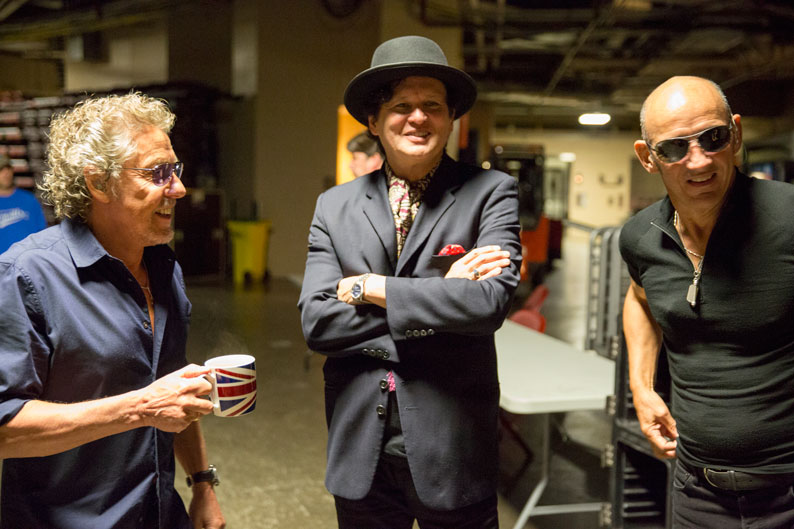
The Who and I
My Amazing Journey From Tokyo To LA To London
A brief introduction to Frank Simes, Musical Director of The Who. Frank, when did you start playing guitar?
I was born in Ichigaya in the Shinjuku Ward of Tokyo, and raised in Kagurazaka until age seven, and then our family moved to Camp Zama, a US Army base roughly 30 miles south of Tokyo. I attended American schools, but spoke both English and Japanese at home, as my father was American and my mother is Japanese. My parents gave me an archtop acoustic guitar for Christmas in 1966 when I was 10. My sister showed me how to play ‘Love Me Tender’, and her boyfriend taught me some Ventures’ music. I also taught myself how to play other Ventures songs like ‘Raunchy’ and ‘Walk Don’t Run’ from an instructional record. At home, we also listened to Ray Charles, The Platters, The Animals, Miles Davis, Elvis Presley, and John Coltrane. Later, I picked up licks and songs by Jimi Hendrix, The Bee Gees, and The Beatles. I played in three-piece bands at talent shows and school dances.
And you became a Who fan by watching the movie Woodstock in a movie theater in Japan?
I discovered The Who’s Tommy in 1969, and then in 1970 I was picking off Pete Townshend licks from Live at Leeds. When the film of Woodstock was released, I spent all my allowance money to see it eight times at a theater in Shinjuku. All the bands and artists in the film were amazing, but when The Who would appear playing ‘See Me, Feel Me’ I was mesmerized, breathless. I said to myself, “That’s what I want to do!” At that moment, I wanted somehow to dive into the movie and be on stage with them. I found their music unique and imaginative. I didn’t realize then that this was the start of a lifelong commitment to music, sprung from a desire initially inspired by The Who. Pete Townshend’s songs drew me into a narrative, and Roger Daltrey’s singing and delivery added a rich, storytelling dimension. In many ways it is surreal that I heard The Who in Tokyo, almost 10,000 miles away from England, and then wound up playing with them as their musical director and multi-instrumentalist. Perhaps the way my musical life fell into place with The Who should be my personal interpretation of ‘I Can See For Miles’!
So, tell us how you left Japan for the States to pursue your dream.
Before I left Japan in 1971, I was playing with Mickey Yoshino and Steve Fox (of Godiego fame) in a band dubbed Sunrise. My lifelong friend and singer Ann Lewis introduced the band to her producer, who, upon attending one of our rehearsals, offered us a seven-year contract with RCA Victor. My father was preparing to retire from the Army, and had planned a summer trip with my older brother and me through the USSR (Russia), Germany, England, and the US. He had also intended to settle near San Diego. Of course I was torn between staying in Japan, or starting a new life in the States. A Victor Records executive came to visit us at Camp Zama to sway me to stay or return to Japan after our trip. My father said it was entirely up to me. In the end, I decided that Japan was a kind of cul-de-sac in terms of my aspirations, and chose instead to pursue my musical dreams in America. Three years later, I had the chance to become the guitarist for Godiego, but I also turned down that opportunity and chose to stay in Los Angeles.
How did you first meet Roger and become his musical director?
Around 2004, Roger was living in Van Nuys, California, and had assembled a charity band named The How. He wasn’t pleased with the band’s guitarist so he replaced him with a second guitarist, who was later also fired. Roger asked the band members, “Doesn’t someone know a guitarist that can play The Who?” Two members of the band, guitar enthusiast, Nigel Sinclair (also an Oscar- and Emmy-award-winning film producer), and drummer, Rob Ladd (Don Henley, Alanis Morissette), spoke up and recommended me. Nigel was a fan of mine and had seen me play with Don Henley, and I had helped Rob become the drummer for Henley. I got a phone call from Roger’s musical director who asked me to attend a rehearsal.
The story that follows is dreamlike or a scene from a movie . . . I went to the band’s makeshift rehearsal space at a nightclub in West Los Angeles, set up my amp, and began tuning my guitar. Suddenly, Roger sauntered in the front door with guitar in hand, nonchalantly playing ‘Behind Blue Eyes’. Well, I knew the song, so I started playing it with him. He looked at me, nodding as if to say, “Oh, you know it”. Surrounded by the other band members and the entourage, we played the entire song together and I sang the backing vocals. At the end of the song, Roger turned to me smiling and said, “That’ll do!” Then he introduced himself, “…Roger.” In other words, we exchanged introductions only after we had played music together!
We played two shows, a warm-up at the same nightclub, and a bigger show at the Henry Fonda Theater in Hollywood. At the first show, Roger squeezed his way through the packed house and asked me, “How would you fancy putting together a quartet and doing some corporate shows?”, to which I answered, “I would fancy that!”
Later, I organized an audition in North Hollywood where Roger, Simon Townshend, and I tried out 33 musicians, and then selected Scott Devours as the drummer, Loren Gold as the keyboardist, and Jon Button as the bassist. Roger called the band No Plan B, and we did several tours, including a world tour of Tommy and an opening spot on two tours with Eric Clapton.
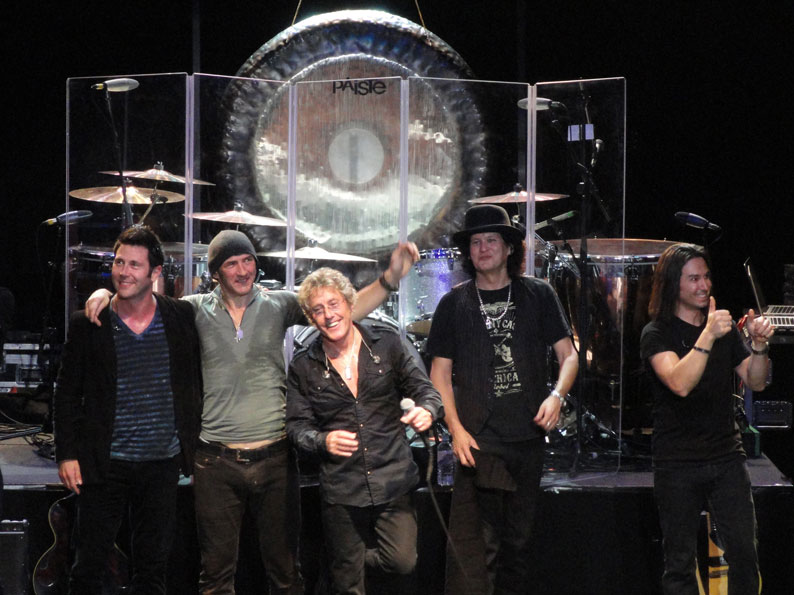
Tell us your memories of the Roger Daltrey Plays Tommy Japan tour 2012.
Touring Tommy in Japan with Roger was an epic homecoming for me. My family – my mother, my sister Hiroko and her husband, my brother Parker, my niece Haruko – attended the shows in Tokyo, Yokohama, Nagoya, and Osaka. On stage, with no warning, Roger told me to translate his English banter to Japanese, which I did. The crowd was astonished that I spoke fluent Japanese, as I translated to the audience about Roger’s start in life in war-torn London, that he worked at a sheet-metal factory, and how he got started playing music while emulating Elvis.
We were almost forced to cancel the tour when John Button got in an motorcycle accident four days before our departure to Japan. I quickly secured a replacement bassist, Jamie Hunting, taught him all of Tommy and 20 other songs (getting three or hours of sleep each night), and helped him obtain a work visa. The trip to Japan was like a dream in three ways: I was playing Tommy with Roger, it was a big homecoming, and Jamie and I had dreamt of playing music in Japan together.
And then you became the musical director of The Who for the Quadrophenia & More tour 2012/2013?
I first met Pete Townshend at Shepperton Studios when he attended a Tommy rehearsal with Roger’s band. We were very excited to meet him, and awaited his arrival with bated breath. He came in smiling, greeted the other members, and left me for last. Immediately, there was a sense of simpatico between us, as he seemed to appreciate the efforts I took to resurrect the vocal harmonies from the original recordings, and to tease out the minutest details of the arrangements. We joked and exchanged many stories.
The second time I was with him was when Pete joined Roger on stage at the Royal Albert Hall for a Teenage Cancer Trust concert. Playing ‘Baba O’Riley’ at the Royal Albert Hall was the one time that Pete and I played guitar together on stage. When it was time for the solo, he graciously motioned me to play it. Suffice to say, I was amazed to be on stage with Pete.
In 2012, Pete contacted me to help him and Roger organize the musical sequence for The Who’s performance at the London 2012 Olympics. Of course, I was honored and delighted to do the work.
For the Quadrophenia & More tour later that year, with Roger’s urgings, Pete decided to try my hand at orchestrating the music for the production. I wrote out all the vocal harmonies, and arranged and scored the horns and synthesizer parts. I also created four-part string arrangements, as using string players was a possibility. I hired two brass players, J G Miller and Reggie Grisham, both of whom could play trumpet, trombone, mellophone, and euphonium. The horn parts comprised five parts, so the two horn players played two of the parts, and I handled the remaining three parts on keyboards with custom-made samples. I made a dozen new audio tracks for live use. I made over 300 mixes of the songs, trying different tempos and keys for various songs. I also inducted John Corey as the pianist. On a side note, both Pete and Roger think John’s piano-playing is inventive and extraordinary.
And then I showed up at the first Quadrophenia rehearsal in Florida. Pete looked at me and said, “Well, we can only have one leader, and you, Frank, are the leader, so tell us what to do…” So, I suggested that we try playing Quadrophenia top to bottom, and then go back and work out the trouble spots as needed. Pete said, “OK. That’s what we’ll do.”
Describe the complexity of the compositions, and how you wrote scores for all the instruments for the tour.
It was a monumental task, I admit, and I suppose I didn’t have to write such extensive scores, but the sheet music helped keep the learning of and rehearsing the parts organized. Spot checks would give me reference to keys, modulations, structures, number of measures, horn parts, and complex vocal arrangements without confusion. Pete called this my “forensic work”. Evidently, no one had previously scored The Who’s music to this extent. Getting the parts right without any equivocation helped tighten up the whole musical presentation.
The entire body of scores of the vocals and instrumental parts and their extractions, and lead sheets for Quadrophenia, The Who Hits 50! tour and Tommy, tallies up to over 2,000 pages. The longer scores, including ‘A Quick One, While He’s Away’ and ‘Doctor Jimmy’, were over 80 pages and 90 pages, respectively.
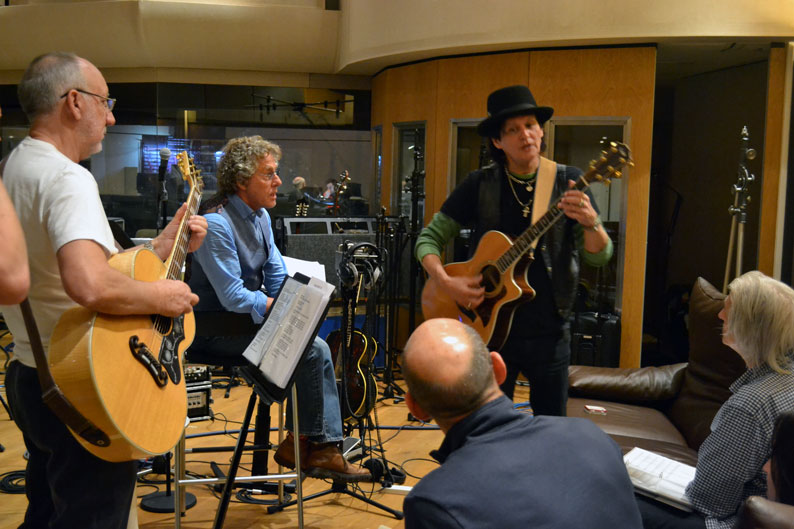
Please share some road stories from the Quadrophenia & More tour and The Who Hits 50! tour.
When Zak Starkey, for medical reasons, was unable to play the San Diego show, I received a phone call at home at 9.00am from The Who’s co-manager Robert Rosenberg, asking whether I could find a replacement drummer for the show. I said I would try my best. I called Scott Devours, and he immediately agreed to take on the seemingly impossible task. Scott was familiar with about 60% of the rock opera. On his way from Long Beach to San Diego, he learned the rest. The painfully funny thing was that in the car, an old VW Beetle, driven by his friend who agreed to drive while Scott studied the drum parts of Quadrophenia, the CD player malfunctioned, and would return to the beginning of the disc when Scott pressed rewind, needing only to go back only a few seconds to hear and study a certain passage again. I have no idea how Scott learned what he needed to absorb. But, he arrived at the arena for the rehearsal/soundcheck, and played through the piece without a hitch. Amazing.
Before he played the first note at sound check at the arena in San Diego, Pete walked over to Scott, who was sitting on his drum stool preparing to play all of Quadrophenia, and gave him the option of bowing out. He said, in essence “It’s up to you. If you don’t think you can’t play it, it’s OK. We can cancel the show, and insurance will cover all the losses. So, it’s up to you to decide whether to play or not.” Scott answered, “I’ve been waiting for this moment all my life. I will definitely play.” Pete was suspicious at first, but was bowled over by his performance when we played Quadrophenia from start to finish. That night, Scott played the whole of the rock opera with only minor errors here and there. But over all, he was spot on and on fire.
Roger was encouraged and encouraging of Scott from the outset.
Incidentally, every time we played ‘The Rock’ at rehearsal, there was a strange dissonance that Pete noticed in the harmony of the instruments when we played the passage “Is it me for a moment”, which otherwise occurs in the theme with vocals in ‘Dr. Jimmy’. I listened to the original multitrack of Quadrophenia and discovered that John Entwistle had played a wrong note under the word “moment”. He had played the fifth (C) with the Fm7(b5), which clashed with the flat-5. Pino had been faithfully playing the very note that Entwistle had played originally. I had him correct it by playing the root of the chord.
How did Tommy Live at the Royal Albert Hall come about? How did the band prepare for these special shows?
It was time to play another charity show at the Royal Albert Hall for the Teenage Cancer Trust. We had already played Quadrophenia for the charity back in 2012, and we had played hits for the same event two years later, and therefore it was time to play Tommy. Initially, Roger had the idea to play Tommy acoustically, but after going back and forth with Pete and me, it became apparent that Tommy would be best played mostly with electric instruments. We rehearsed the show in a studio in London for four days, then played the two RAH shows soon after. There was a lot of material, especially in terms of vocals, to cover in four days, but we managed to cover all the bases and pull off the show. I even played the banjo on ‘Tommy’s Holiday Camp’.

What are your thoughts on the performance at the Royal Albert Hall?
Considering the time crunch of having to rehearse the songs and work out the details of the transitions between them, I thought we did an excellent job. It required everyone in the band and crew to be extremely focused and on point. The crowd was exuberant, which was a good sign that we did more than just standing up to the challenge. Roger’s singing was spot on, and Pete was on fire, as usual.
What was it like for you, who became a Who fan by watching The Who playing Tommy in Woodstock, to perform The Who’s Tommy in their home town?
I saw my brother’s friend carrying around an LP of Tommy, which he held like a treasure. The cover art intrigued me. It was surrealistic, like a painting by Rene Magritte. Then, I went to see Woodstock, and saw The Who on the screen. And that’s when The Who took my breath away.
I had a fantasy of diving into the film of Woodstock and playing with The Who as I sat in the movie theater in Shinjuku. It almost seems as though that wide- and glazed-eyed boy of 14 did make the plunge through the movie screen to sing “Listening to you, I get the music…” with The Who, entered a time machine, and came out on the other side 42 years and 10,000 miles later to direct and lead The Who to play Tommy in their hometown of London. What are the odds? I have come to realize that intention, preparation, commitment, enthusiasm, and attention to detail can take you a long way…
On one level, it seems like an act of magic, an otherworldly wave of a wizard’s hand that helped me fulfill a dream to become the musical director of The Who, but on another level, I know it simply took a lot of work and thought and determination. But, there is a boy that’s still alive in my heart that gets a giant thrill and is filled with soaring wonder when I’m up on stage with The Who, singing, “Listening to you, I get the music…”
I see that Pete’s songs and the power of The Who is at least double-layered. One layer of the power lies in the visceral aggressiveness of Pete’s guitar playing, Roger’s vocal strength, Keith Moon’s big, dynamic, orchestral style of playing drums, and John Entwistle’s thunderous bass guitar. One might describe it as “proto-punk”. It’s earthy, but there are many elements of sophistication, as well.
The other layer is the celestial quality of the complex vocal harmonies. The backing vocals are imaginatively conceived and beautifully sung. They are often much more intricate than it may sound to the lay listener.
Therefore, with The Who the listener gets the earth of the rock and the heaven of the harmonies, so to speak. Heaven and earth as one. This is where The Who’s magic lies.
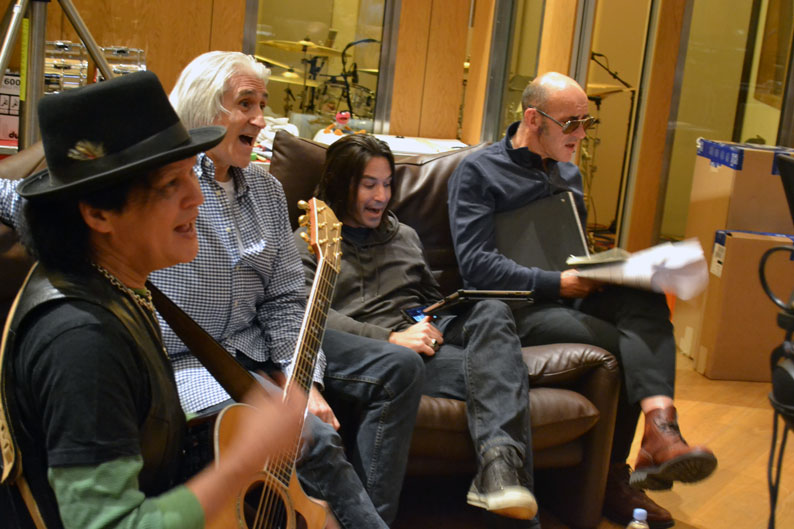
One of my main contributions to the current Who is that I have revived the vocal harmony arrangements from the original recordings, scored them, and got the band’s backing vocalists to sing the parts live correctly. In this way, The Who were slightly transformed. The original line-up with Pete, Roger, Keith, and John allowed only one lead vocal and two backing vocals. But, many of their songs had four, five, or more parts. To name a few examples, songs such as ‘I Can See For Miles’, ‘The Kids Are Alright’, and ‘Join Together’ have five vocal parts if lead vocals are included, and ‘A Quick One, While He’s Away’ has six parts. In Tommy, songs such as ‘Cousin Kevin’, ‘Fiddle About’, and ‘Do You Think It’s Alright?’ also have five-part vocals, and ‘I’m Free’ has six parts if you counts all the variations.
As a last word, The Who represents the soul of rock ‘n’ roll, and more so than any other internationally acclaimed band. Their music and Pete’s lyrics embodies the spirit of freedom, reminds us to not sheepishly accept the status quo, and stands by and for the angst-driven teenager who is bound to awaken to a world that is quick to shun his or her hope to love and to express oneself openly. In these ways, The Who are the one band that is wholly based in the spirit and ideology of liberation. I am proud and honored to be a part of such a band.
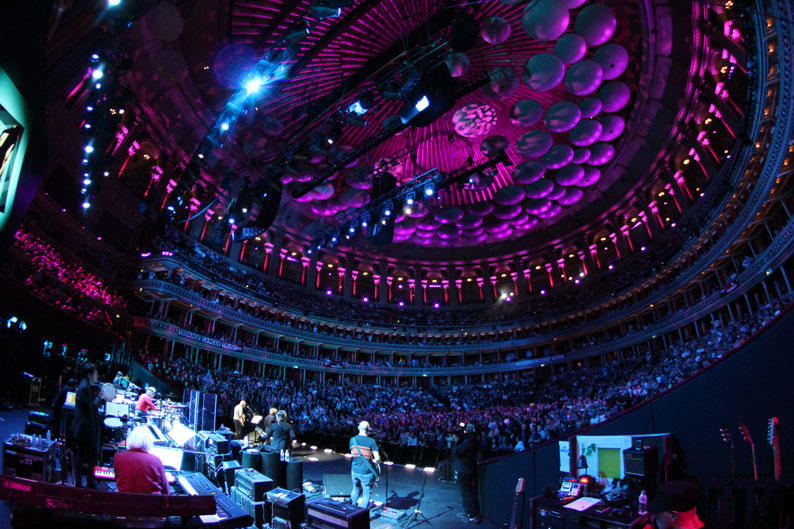
Photos by William Snyder, Brian Kehew and Amy Rosenberg.
With thanks to Frank Simes, Dai Nagata, Go Tada at Universal Music LLC and Rie Tsubouchi.

OMG, this was an amazing read especially after seeing Roger Daltrey and his band perform at the Rock Legends Cruise X last week. I was so curious who Frankie Simes was (not knowing his name) and now I know, he is the talented music director for the band and amazing guitarist amongst many other things in life. Rock on!!!!